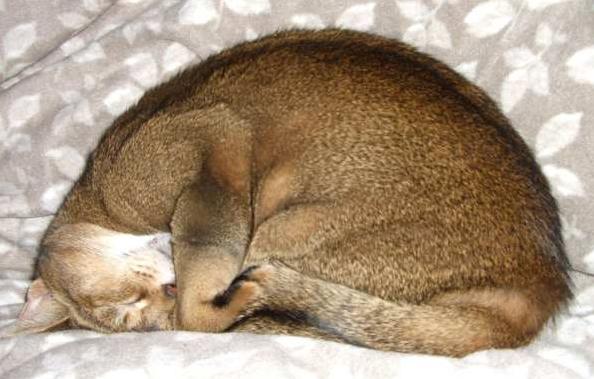Eumelanin is a pigment in domestic cats and other animals (and humans). It is often referred to as melanin but in fact there are three different types of melanin: eumelanin, pheomelanin and neuromelanin. The two that concern me in this article are eumelanin and pheomelanin.

The pigment melanin is in human skin, eyes (iris) and hair. For the domestic cat, the black pigment in tabby cat hair is eumelanin and it is set against a yellowish ground colour produced by the pigment pheomelanin. The agouti gene controls the agouti-signalling protein which controls the amount of pigmentation and type of pigmentation that is deposited in the hair strands. The pigment is produced in a cell within the hair follicle called a melanocyte from where it is deposited into the hair strand as it is created and grows.
As the amount of agouti protein increases within the melanocyte the production of eumelanin is inhibited which results in an increased production of pheomelanin which is then deposited into the hair shaft.

Ticked tabby
The agouti protein inhibits the production of pheomelanin but less so than eumelanin resulting in a hair shaft that is black at the top but yellow at the base. The overall effect on a cat when the hair strands are bundled together is the characteristic ticked, agouti coloration that you see on Abyssinian and Somali cats for instance. You see this coat on mice and rabbits. What I have described above is one form of an agouti tabby coat. It’s the ticked coat. There are also mackerel,, spotted and blotched tabby coat as you might know. The most common cat coat is the tabby. The wild ancestor of the domestic cat, the North African wildcat, has a faded tabby coat.
I’m not going to go into any more detail about the genetics because it is beyond my remit and knowledge. I would urge people to read Sarah Hartwell’s website messybeast.com if you want to read in detail about the genetics of cat coats including the tabby.
The bottom line is that genes control the production of melanin and pheomelanin in various quantities which is deposited in hair shafts in various ways to create a the unlimited number of variations of coat types that you see in domestic cat coats.
P.S. neuromelanin is concerned with brain function and irrelevant to this article.

